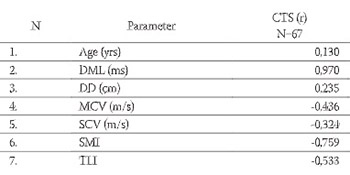Sensory-Motor Index is Useful Parameter in Electroneurographical Diagnosis of Carpal Tunnel Syndrome
DOI:
https://doi.org/10.17305/bjbms.2006.3139Keywords:
sensory-motor index, carpal tunnel syndromeAbstract
It was performed electroneurographic (ENG) studies with surface electrodes and examined nervus medianus (NM) in 60 patients (38 females), average age of 50,28 years (X+/-SD=50,28+/-11), with clinical diagnosis of carpal tunnel syndrome (CTS) and at least one border or discrete abnormal value of conventional electrophysiological tests. It was also examined 57 healthy individuals (33 females) as control group, average age of 45,65 years (X+/-SD=45,65+/-9,68). The sensitivity and specificity of sensory-motor index (SMI), terminal latency index(TLI) and residual latency (RL) were calculated and compared. SMI is determinate by using following formula: distal distance (DD) (in cm)/distal motor latency (DML) (in ms) + sensory conduction velocity (SCV) (in m/s)/motor conduction velocity (MCV) (in m/s) of NM. SCV of NM was measured by antidromic technique in segment wrist-index finger and MCV of NM in forearm segment above wrist. SMI mean value of control group was 3,45 (X+/-SD=3,45+/-0,45) with lower limit of normal value 2,82 and in patients with CTS 2,13 (X+/-SD=2,13 +/-0,37). The sensitivity of SMI in patients with CTS was 98,51%. SMI is useful parameter in electroneurographical diagnosis of CTS and it's determination is easy and fast and specially important in cases with border or discrete abnormal values of other NM electrophysiological parameters, when SMI values can indicate incipient phase of CTS evolution. In rare cases (about 1%) of CTS with selective NM motor axons affection, SMI may have normal value (false negative result), but DML is always prolonged in this cases. SMI is not dependent on age and DD values in patients with CTS and control subjects.
Citations
Downloads

Published
Issue
Section
Categories
How to Cite
Accepted 2018-02-06
Published 2006-08-20









